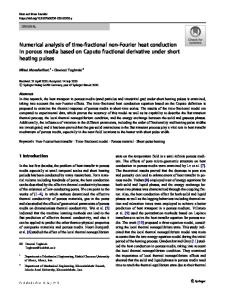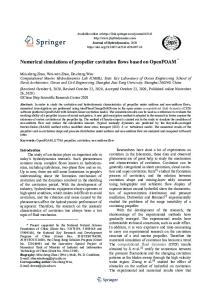Numerical simulations based on shifted second-order difference/finite element algorithms for the time fractional Maxwell
- PDF / 4,097,096 Bytes
- 15 Pages / 595.276 x 790.866 pts Page_size
- 79 Downloads / 338 Views
ORIGINAL ARTICLE
Numerical simulations based on shifted second‑order difference/finite element algorithms for the time fractional Maxwell’s system Enyu Fan1 · Jinfeng Wang2 · Yang Liu1 · Hong Li1 · Zhichao Fang1 Received: 11 May 2020 / Accepted: 13 August 2020 © Springer-Verlag London Ltd., part of Springer Nature 2020
Abstract In this article, mixed element algorithms with second-order time convergence results for the two-dimensional time fractional Maxwell’s equations in the Cole–Cole dispersive medium are developed. Fully discrete mixed element systems with shifted parameters 𝜃 at time t = tn−𝜃 , which are constructed by combining the generalized BDF2-𝜃 schemes in temporal direction and a mixed element method in space direction, are formulated. For the two-dimensional case of the fractional Maxwell’s system, the algorithm implementation process based on the rectangular subdivision is shown in detail. Finally, two numerical examples are provided to confirm the validity of our method and to analyze the influence of parameters 𝛼 , 𝜃 for numerical solutions. Keywords Time fractional Maxwell’s equations · Generalized BDF2-𝜃 schemes · Finite element method · Dispersive medium
1 Introduction The electric permittivity or the magnetic permeability of dispersive medium is associated with the wave frequency in electromagnetism, and waves with different frequencies in dispersive medium travel at different velocities. In practical problems, one can find many examples of dispersion medium, such as biological tissue, soil, plasma, water and optical fiber. Since the 1990s, researchers have used various numerical methods to solve the wave propagation model in dispersive medium, and obtained the corresponding numerical solutions, for instance, finite element method [1–8], finite difference method [9–13], discontinuous Galerkin method [14–18], etc. There are several common dispersion models to describe the dispersion behavior of materials, such as Drude model, Debye model, Lorentz model and Cole–Cole model. However, experimental results show that the Cole–Cole model can describe accurately the frequency dependence of many * Yang Liu [email protected] 1
School of Mathematical Sciences, Inner Mongolia University, Hohhot 010021, China
School of Statistics and Mathematics, Inner Mongolia University of Finance and Economics, Hohhot 010070, China
2
materials compared with other models, which is of great significance in the application of microwave medical imaging. In 2011, Li et al.[1] constructed two fully discrete mixed finite element schemes for Maxwell’s equations with the Cole–Cole dispersive medium, in which the time fractional derivative is approached by L1-approximation. In [19], Huang and Wang presented a numerical method for Maxwell’s equations in the Cole–Cole dispersive medium based on the spectral-Galerkin method in space direction and the multi-step spectral-collocation approach in temporal direction. In [20], Rekanos and Papadopoulos proposed a new finite difference time domain method to solve Maxwell
Data Loading...











